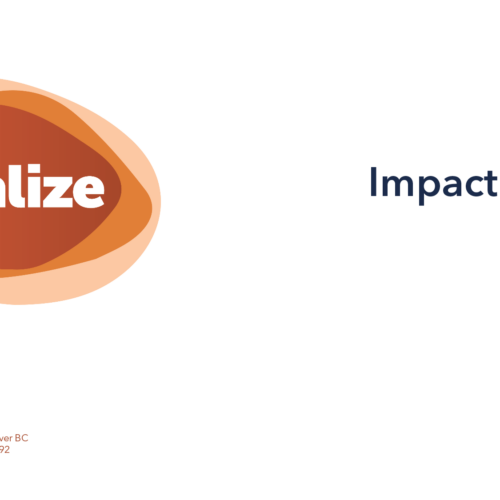Re-Solidify Your Culture in the “New Normal”: 3 Ways to Bolster Culture Through Purpose
Published on June 16, 2020
As we’re slowly and cautiously starting to reopen and navigate our “new normal”, there are a lot of frank and potentially difficult conversations and work to be done. What is your work culture going to be like as laid off employees are brought back? How much trust is there between staff and leadership? Is everyone going to continue working remotely from now on? Organizations have an unprecedented opportunity to embrace the positive (and maybe unexpected) changes and learnings that have emerged through the past few months and recalibrate their strategy and culture to make the most of the new normal. We’re starting a two-part series on Re-Solidifying Your Culture in the “New Normal” and sharing tools to help you address and navigate these questions.
Workplace culture is your organization’s strength and competitive edge. A strong and healthy work culture is what makes people – the ones running, building, innovating, and bringing in money for your company – want to join your organization, stay, and thrive. Since the COVID-19 pandemic has swept around the world these past few months, many of us have been putting out fires as fast as we can and taking things day by day. As organizations and leaders, we’ve had to focus on the safety of our frontline workers, handling temporary or permanent layoffs, pivoting business plans to stay afloat, rapidly transition to working from home wherever possible, supporting the mental health of employees, and more. Here are 3 ways to re-solidify your workplace culture though purpose and compassionate leadership.
The bottom line for leaders is if they do not become conscious of the cultures in which they are embedded, those cultures will manage them. Cultural understanding is desirable for all of us, but it is essential to leaders if they are to lead.
Edgar Schein, Ph.D., Former Professor at MIT and recognized authority in the field of Organizational Culture and Leadership
1. Check-in on your organization’s values
Your organization’s values may have strengthened or shifted during the disruption of the last few months. It’s important to ensure that your values are accurate, role-modelled, and rewarded by leaders and also aligned with your mission and strategy. Many organizations have a list of values on their websites or in their strategic plan, but your real core values are what guide your actions. By having clear values, you will set a strong foundation for your culture.
When re-solidifying your culture, it will be important to check in on your values and consider these questions:
- Are your core values embedded in everything you do?
- Do they demonstrate what your organization stands for, what you do, and how you do it?
- Are they true both externally and internally?
- Do all employees understand what they mean?
- Do they have clear behaviours associated with them?
- Do leaders actively support the behaviours associated with your values?

If you feel like your values don’t accurately represent the culture you want to bring forward into the new normal, take the time to gather input from your employees and collaborate to form the right list of values. Each value should be clearly linked to associated skills and behaviours that are important to the success of your organization.
A great example of how to effectively capture your values through behaviours is the way Netflix defines its value of “Selflessness”:

2. Lead With compassion and authenticity
For many purpose-driven organizations, the bedrock of their approach to managing COVID-19 is leading with compassion. Now more than ever, there is a greater need to take care of your teams as people first, and employees second. There is so much more going on for the people within your teams than the work they do each day.
Compassionate leadership is often described as having three core areas:
- Empathy: Understanding how someone else is feeling, even if it is uncomfortable.
- Cognitive: Mindfully listening to others and seeking to identify what they are thinking and why.
- Motivation: Taking care of the concerns of others and trying to reduce their suffering.

Compassionate leadership is a skill that can be strengthened over time. It will be more developed in certain people within your organization, which should be considered in determining the responsibilities of your core leadership team. Check out our full post about leading with compassion during tumultuous times.
To develop compassionate leadership, reflect on the following questions:
- As a leader, what am I doing to support my own well-being and model self-compassion?
- Who in my organization excels at showing empathy? Are they placed in a position where they are providing support for others?
- How are employees doing in their personal lives? Is there anything the organization can do to help?
- How am I ensuring that employees feel comfortable taking breaks?
- How are we developing “soft skills” in our leaders?
3. Double-down on accountability and communication
Clear, direct, transparent communication is an integral tool for all leaders, especially during times of uncertainty. One of the biggest causes of anxiety and stress right now is the unknown. People don’t know how this pandemic will affect them personally or professionally, how long it will last, the future and stability of their role and organization, or how it will continue to impact the local, national, and global economy. Thoughtful, transparent, and regular communication combined with clear availability can abate some of this uncertainty. For example, some leaders are providing regular blocks in their calendar for calls regarding issues associated with changes brought forward from COVID-19.For many purpose-driven organizations, the bedrock of their approach to managing COVID-19 is leading with compassion. Now more than ever, there is a greater need to take care of your teams as people first, and employees second. There is so much more going on for the people within your teams than the work they do each day.
Accountability is multi-directional. Employees are accountable to leaders, but leaders are also accountable to employees – something that is important for leaders to keep in mind. Communication is a key component of accountability – if you want your employees to be accountable to the organization, they need to have an awareness of what the organization is facing.
To ensure you are creating a culture of accountability and communication, ask yourself:
- As a leader, have I been clear about my expectations?
- Are employees comfortable asking “what can I do to help”?
- On a scale of 1-10, how much clarity do employees have on the current situation at the organization?
- What kind of communication resonates most with employees across the organization?
- Are different communication strategies required for different teams or different individuals?
COVID-19 has made us all reconsider the traditional parameters and format of work and made us innovate to keep things going. As we transition back to a schedule that may feel more familiar than the last few months have felt, let’s not forget the insights we’ve gathered to make a better workplace experience. Build a stronger culture by focusing on your organization’s purpose and values and lead with compassion and accountability.
Contributors




